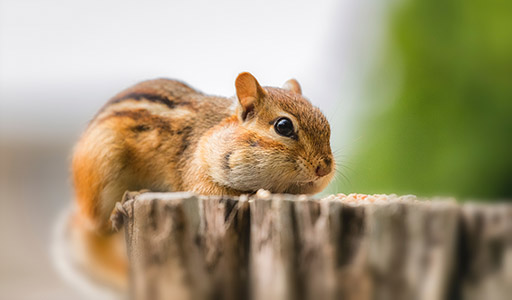Chipmunks

Chipmunk Information
Chipmunks are known and loved for their chubby cheeks and lightning fast speed. These adorable creatures typically survive for about 2-3 years in the wild and typically never grow heavier than 1 lb. in weight. Chipmunks occupy most of the United States and parts of Canada. Chipmunks primarily live in trees, logs, and shrubs and dig extensive burrow systems under the ground. During the winter, chipmunks live in their underground burrows along with the food they have been stockpiling all year.

What does a Chipmunk look like?
Often thought of as miniature squirrels, chipmunks have small pointed heads, four legs, and claws on their feet. Only reaching about 6 inches in length, the rodents are hard to spot. Eastern chipmunks are brown with stripes of white above and below their eyes. They also have white and black stripes running down their backs. Western chipmunks look very similar. However, their stripes are more defined and their fur appears reddish-brown. Both species of chipmunks have bushy tails that add an additional 3 inches to their overall length.

What does a Chipmunk eat?
As they are omnivorous creatures, chipmunks keep extremely versatile diets. The rodents eat mostly nuts, seeds, fruits, grass, and other types of vegetation. Chipmunks will also consume small animals, such as frogs and worms, in addition to unattended bird eggs.

Chipmunk habits
Chipmunks generally like wooded areas that offer plenty of cover from predators. They especially like to burrow under rocks, logs, and brush piles. Chipmunks are widespread throughout the Nearctic region and occupy both urban and suburban environments where trees are present. We most commonly remove chipmunks from properties in Georgia, Texas, North Carolina, Louisiana, and South Carolina. Contact your local Trutech office today to learn about our chipmunk removal and exclusion services!
Identifying Chipmunk Damage
Since it’s so similar to the problems caused by comparable pests like rats and moles, chipmunk damage can be difficult to identify. However, there are some distinguishing characteristics to look for. Moles and chipmunks both burrow, but the former leaves mounds by the entrances to their nests while the latter does not. Instead, chipmunks use their cheek pouches to carry the dirt away from the burrow. They also conceal entrances by placing them near shrub roots or birdfeeders. This keeps them close to their food supply.
Winter Tracks
Chipmunks don’t hibernate in winter, but do enter a period of inactivity. Therefore, it is uncommon to see chipmunk tracks in snow. The animals spend most of that time in their burrows, eating food they stored previously and only coming out during sporadic warmer days.
Frequently Asked Questions
Chipmunks mate twice a year. After about 31 days, the female gives birth to a litter of young. The mother will wean and leave her young ones once they start to emerge from the burrow. After that, these young adults disperse to find new territories and mates.
Females give birth to litters of two to six baby chipmunks. Newborns are hairless, blind, and deaf. Mothers wean their young for about three months before they are ready to survive on their own.
Females raise baby chipmunks alone within underground burrows or tree nests. Chipmunk dens consist of tunnels that lead to a central chamber. Inside this space, leaves, grass, and fur keep the nest soft and warm. Burrows are suited for cold weather, while trees are more practical during the summer months.
Since chipmunks create underground tunnels to live in, homeowners don’t often see the pests’ feces. In fact, the rodents have chambers in their burrows specifically designated for waste. On some occasions, chipmunk droppings can be spotted on patios, in sheds, and in garages but are commonly thought to be mouse or rat poop. This is because all of these rodents produce pellet-shaped feces that are about the size of a grain of rice. Chipmunk droppings are just under a centimeter in length and typically brown to black, though color can vary based on diet.
Chipmunks thrive across the central and eastern U.S. The chipmunk lifespan averages about eight years in captivity. In nature, the life expectancy of a chipmunk is much shorter. Since it is vulnerable to predators and the elements, the eastern chipmunk lives about two to three years in the wild.
Chipmunk tracks will show four toes on the front feet and five on the back feet. Their tracks are characterized as multiple-diagonal. This means all the footprints are laid down in one set, and the tracks from the front feet will be slightly askew rather than parallel to one another. In this grouping, tracks from the back feet will actually appear first. This is because chipmunks leap, and they land on their front feet before digging in for the next jump with their back feet. Cottontail rabbits make a similar track, although theirs will be larger than a chipmunk’s.
Chipmunks and gophers have some shared characteristics. For instance, they are small, burrowing animals that often create extensive underground tunnel systems near homes. They both have large, fur-lined cheek pouches for carrying seeds and are solitary, except during breeding periods. Finally, neither chipmunks nor gophers hibernate, instead remaining active year-round in their burrows.
Gophers have small, fairly flat heads, short necks, clawed forepaws, and lips that close behind their incisors. They range from five to fourteen inches long and can be nearly black to pale brown in color. Chipmunks are commonly brown, tan, or white with a reddish hue and have slender, athletic bodies. They are distinguished by the black markings running down their backs and white stripes above and below their eyes. Including the tail, chipmunks are approximately eight to ten inches long.
While squirrels bring to mind fluffy tails and tree-climbing antics for most people, ground-dwelling species, such as chipmunks, are also part of this rodent family. Chipmunks are easy to tell apart from tree squirrels because their tails are not nearly as long or bushy. A tree squirrel also typically weighs about a pound, while a chipmunk weighs a few ounces. The smaller pests are brown in color with alternating dark and light stripes. Unlike other ground squirrels, a chipmunk’s stripes continue up its back and across its face.
Gophers have small, fairly flat heads, short necks, clawed forepaws, and lips that close behind their incisors. They range from five to fourteen inches long and can be nearly black to pale brown in color. Chipmunks are commonly brown, tan, or white with a reddish hue and have slender, athletic bodies. They are distinguished by the black markings running down their backs and white stripes above and below their eyes. Including the tail, chipmunks are approximately eight to ten inches long.
Chipmunks are burrowing rodents that build tunnels in homeowners’ backyards. The pests dig about three feet down to create a chipmunk den that stays warm in the winter. These burrows can ruin landscaping and cause property damage.
Chipmunk hibernation is somewhat restless, as the pests do not fall into a deep slumber. Instead, they wake from time to time to eat from their caches of food. Chipmunks may even emerge on warm days to forage.


